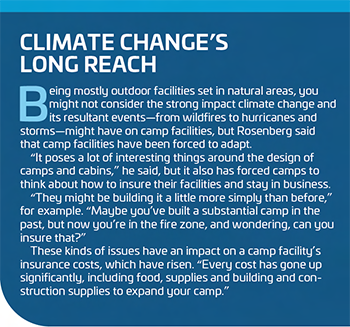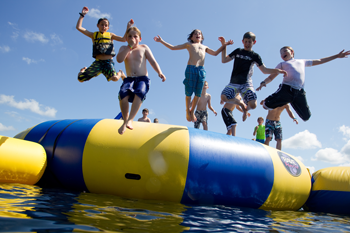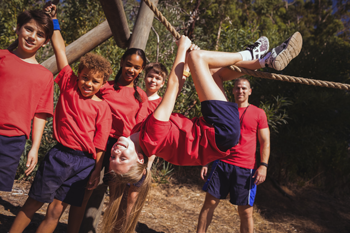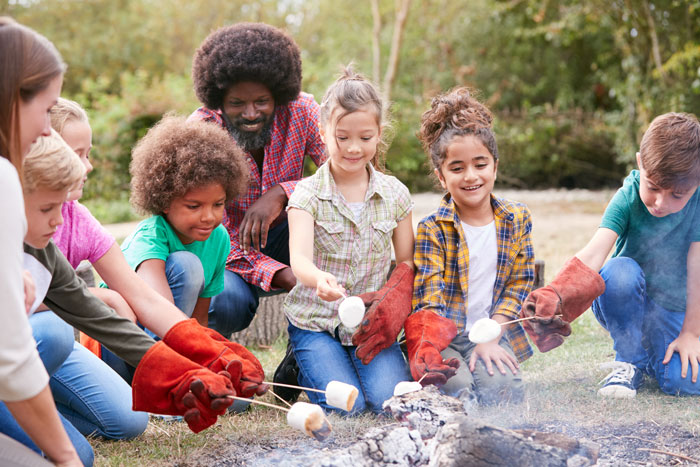Summer Camps Continue to Evolve With the Times

Wait a second. Are the kids alright? A U.S. Department of Health and Human Services study found a significant increase in the number of children diagnosed with mental health conditions between the years 2016 to 2020. That short timespan saw a 29% increase in anxiety diagnoses and a 27% increase in depression diagnoses in kids from 3 to 17 years old, a growing problem that has likely only been exacerbated by the stresses of a global pandemic.
It’s on adults—parents, caregivers, teachers and more—to make sure the kids are alright, and when it comes to support for children’s physical and mental health, as well as their social, emotional and learning development, camp professionals are not waiting in the wings, but taking center stage to ensure these needs are addressed.
That’s in spite of the deep pain inflicted on camp facilities as the pandemic led to widespread closures and steep declines in attendance.
“We’re moving forward through it all,” said Tom Rosenberg, president and CEO of the American Camp Association (ACA), and a strong advocate for ensuring kids have the resources they need to succeed. “Basically, we were absolutely impacted significantly by the pandemic, and in some cases devastated. For a great amount of the field to not operate in 2020 was terrible.”
The majority—82%—of overnight camps and 40% of day camps did not operate in 2020, he said. “That’s a huge hit to the industry, but also to all the kids.”
According to Rich Wills, principal with a Verona, Wis.-based consultant and supplier of waterfront and park products, who often works with camp facilities, the camp market has been rebounding nicely since the pandemic. “Owners and operators are motivated to provide the best experience possible for their campers and staff. One way to accomplish this is that camps reinvest in their camp every year.”
 But while many camps have figured out how to operate and try to give kids a more normal experience than during the height of the pandemic, there are still many impacts, Rosenberg said. Like so many facilities, one of the most difficult impacts to address is staffing.
But while many camps have figured out how to operate and try to give kids a more normal experience than during the height of the pandemic, there are still many impacts, Rosenberg said. Like so many facilities, one of the most difficult impacts to address is staffing.
“What does it mean to staff fully today?” he asked. “The kids need more, individually, than they did before COVID. And the summer staff—college-age young adults—they need different supports. So you need more staff, but also the components of your staff look different, including more focus on mental health for staffers and campers.”
This trend has evolved the camp staff experience from a summer job to a human development experience. “All of them—camper and the young adults who act as staff—have been impacted. Their resilience and emotional regulation, their academic and social-emotional development have been impacted, and perhaps delayed. So this is an opportunity to help everyone grow through the challenges of the past few years, and camp is an optimal place for that.”
Campification & Summer Learning Gaps
Before the pandemic, the National Academies of Science, Engineering and Medicine published a report around summertime experiences and the “widening gap between children who have access and those who don’t have access to those learning experiences,” Rosenberg said. “Then the pandemic happened and those same kids have been devastated by the inequities of the pandemic, so there’s a tremendous call to action for kids who haven’t had equitable access to summer learning to have that access.”
That call to action hasn’t remained theoretical. The American Rescue Plan Act included funding for extended summer learning. As part of that, “the U.S. Department of Education has been working with us to bring more kids camp experiences, both during the summer and during the school year in collaboration with schools,” Rosenberg said.
“We’re working hard to create culturally responsive and equitable camp experiences for families that maybe weren’t aware of day camp or overnight camp,” he explained. “It’s an exciting time to work because there’s a lot of opportunity to expand the field, grow your programs and make them more equitably accessible.”

What does that mean for you, as a camp facility director or other professional working to bring the camp experience to more kids? “That translates to improving facilities and adding capacity so they can serve the tremendous demand.”
But it also has led to the development of far more partnerships between camp facilities and others—not just schools and teachers, but also parks, museums and community institutions like the Y and JCC. “Partnerships have blossomed,” Rosenberg said. “We have strong connections with agencies like the CDC and schools—everyone is working together to help our kids and our families, and it’s interesting to see what will come from that.”
These kinds of partnerships lead to opportunities for camp directors to extend the use of their facilities beyond the summer season, Rosenberg explained. For example, rural camps can work with other local agencies, allowing them to use their facilities throughout the year. “It provides more support for the camp, and more utilization,” he said. “It also gives out-of-school programs more places to do their programming in spaces in nature that are designed for kids.”
This kind of “campification” of kids’ experiences is another big trend. What does it mean to campify something? “It might be more likely to be outdoors. It’s about teaching young people to be part of a community—to communicate, to be more creative and learn how to be more human. I think you’re going to see more learning programs campify.”
This has led the ACA to focus its own work on improving its support for the “growing, wider, deeper field that has so many kinds of programs on and off school property,” Rosenberg said. “We’re working to provide more professional development for a whole new generation and a more diverse, inclusive group of camp people to serve all our school-age children.”
Health & Safety
The pandemic turned a spotlight on how various facilities address communicable diseases, and camps that remained open—as well as those that reopened in 2021—engaged some new protocols to help reduce the spread of diseases like COVID. Many of those changes will be carried forward.
For example, Rosenberg said a lot of camps found ways to offer outdoor dining. “When is one of the few times you take off your mask? Its when you eat,” he said. “So you had to either space the kids out in a way that was not sustainable, or you had to move them outside. I think we’ll see a lot more camps do outdoor dining, so think of all the accessories camps will need to do that in a good way.”
But ensuring kids feel safe is about a lot more than protecting them from the spread of disease. Just as schools have had to add active shooter drills to teach students how to handle such an emergency, camps have also had to address this possibility.
“I don’t think we listen enough to how kids feel about that stuff,” Rosenberg said. “Kids need places in their lives where they can feel physically and emotionally safe to take positive risks. That’s where learning happens.”
For many camps, this has meant thinking about things like gates and barriers, cameras and loudspeaker systems. They have to do all the things schools do, but an overnight camp out in the country is very different. “How do you go about training and securing those spaces?”
Something for Everyone

Like so many facilities providing recreational and learning outlets for people of all ages, camps are also working to reach more people. “Today the big story is about providing equitable and inclusive access to diverse populations—people with disabilities, different abilities, everyone,” Rosenberg said. “The way I went to camp as a boy is not the way children today go to camp. Cultures are different, and those diverse cultures will shape the way that American camp will look in the years to come. We’re looking for thought leadership from diverse leaders to help us shape the industry to best provide for every school-age kid in the years to come.”
From the perspective of ensuring your facility is meeting the most current needs and trends, Rosenberg said to remember how important mental, emotional and social needs are. “What kinds of facility changes might be beneficial to meeting those needs? I see more sensory rooms, and more facilities designed to be more of a sensory experience.”
Non-gender-specific bathroom designs and facilities that make it easier to change privately for swim are also ways to make a facility more inclusive.
When it comes to activities, he said pickleball is “all the rage,” with many facilities looking at converting tennis courts into pickleball, though tennis hasn’t been entirely replaced.
Improving waterfronts is another way many camps are expanding opportunities for fun and activity for campers. “Waterfront improvement is always a top priority for residential summer camps,” Wills said. “The waterfront offers many activities for campers. Over the past several years, camps are adding amenities that include replacing or expanding an existing dock system, upgrading boating options, adding shade and shelters along the waterfront. Camps are also investing in inflatable aqua parks and services that include installation and take-downs of the products.”
For example, Camp Wah-Nee in Connecticut added several docks to expand the activities offered at camp, and Trails End Camp in Pennsylvania added an inflatable aqua park several years ago. “The program is the top activity for campers year after year,” Wills said.
“Camps should consider active recreation options,” he added. “Active recreation promotes outdoor engagement in the natural environment. Many active recreation venues do not require a specialist to run the program. Having counselor-driven activities reduces overall operating costs by eliminating additional staff.”
“The other thing is, don’t forget that during the pandemic our kids didn’t have a chance to move their bodies as much,” Rosenberg added. “They got out of shape. And I think camp directors who saw that have tried to provide healthier meals, or asked, ‘How can I teach mindfulness and wellness and how they move their bodies?’ They even created longer activity periods so there was more time to talk with other kids. Physical fitness and emotional connections are so important.”
That said, Rosenberg reemphasized the importance of providing a safe space. “Without that emotional and physical safety, I think it’s hard for them to work through what they’ve been through.”
With professionals like Rosenberg and summer camp in their corner? The kids are going to be alright. RM



